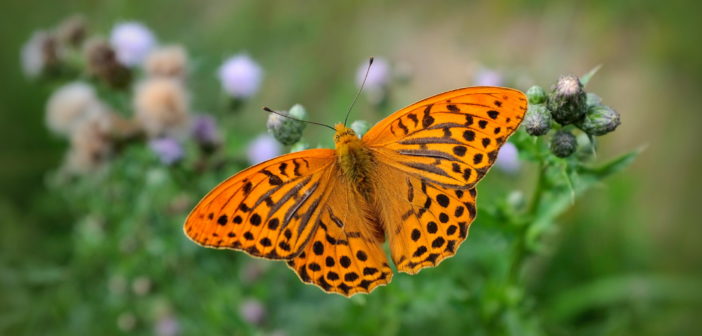A world without insects would be one part sad — no butterflies, no bees — and one part terrifying: a collapse of human food systems, and a planet covered in dung and rotting carcasses.
That’s what scientists warn is coming if insect populations keep declining at their current rate.

A bumblebee on a flower. Plummeting insect populations will have devastating impacts on both wild ecosystems and crops, due in part to their role as pollinators. Image credit Wolf Gordon Clifton / Animal People, Inc.
Up to 40 percent of all insect species may go extinct over the next few decades, according to a global scientific review recently published in Biological Conservation. The result, the study’s authors say, would be “catastrophic collapse of nature’s ecosystems.” Insects play a vital role in pollinating plants and disposing of organic waste. They are the only food source for many species of birds, fish, mammals, and amphibians; without them, food chains would collapse.
Why are insects dying at such staggering rates? The report points to habitat loss, pesticides, and climate change as the main reasons behind the current decline.
None of this comes as much of a surprise to Earthjustice attorney Greg Loarie. He has been fighting to stop the use of a class of pesticides known as neonicotinoids, or neonics, since 2012, when Earthjustice was first approached by beekeepers who suspected that neonics were to blame for a sudden dramatic decline in their bee populations.

Earthjustice attorney Greg Loarie has spent years working to protect insects from pesticides. Image credit Chris Jordan-Bloch / Earthjustice.
“The beekeepers were the canaries in the coal mine,” says Loarie. “Insects aren’t always as closely studied, but commercial beekeepers keep close track. They were starting to lose their bees at rates that were completely unprecedented.”
Neonics were first developed in the late 1990s and soon became the most widely used class of insecticides in the world. The U.S. Environmental Protection Agency (EPA) approved them for use on more than 120 crops — fruits, vegetables, soy, corn, canola, grains — to kill insect pests.
“It’s a 21st-century insecticide that makes the plant itself — including the pollen and nectar — toxic for insects,” Loarie says. “It’s also really easy to use.”
After beekeepers raised the alarm, studies began to show that neonicotinoids, even in low doses, were making bees very sick and causing widespread colony collapse disorder.
“The unintended consequence of inserting all this long-lasting poison into the agricultural system is devastating beneficial insects,” Loarie says. “We’re just starting to realize all the implications of that.”

An owl butterfly snacks on fresh fruit in Costa Rica. If action is not taken, many butterfly and other insect species may become extinct. Image credit Kim Bartlett – Animal People, Inc.
In 2015, Earthjustice represented several beekeepers and beekeeping organizations in a lawsuit that alleged the EPA violated federal law when it approved a neonic called sulfoxaflor without reliable studies of its impact on bees. The Ninth Circuit Court of Appeals agreed, overturning the EPA’s approval.
Then Earthjustice took the fight to California, the nation’s largest agricultural producer. In September 2017, an appeals court overruled the state’s approval of two neonics — a decision that ended California’s practice of rubber-stamping new uses for the insecticide class. Currently, California’s Department of Pesticide Regulation and the EPA are evaluating new restrictions on neonics.
“We’ve successfully put a pause on all this stuff, but a pause isn’t really good enough,” says Loarie. “We need a dramatic ratcheting back.”
As the Biological Conservation report notes, wholesale change needs to occur in the global industrial agriculture system. “The conclusion is clear: unless we change our ways of producing food, insects as a whole will go down the path of extinction in a few decades,” the report warns.
“This is language that scientists don’t typically use,” Loarie points out. “They do when they are trying to flag a substantial crisis. And that’s exactly what this is. You don’t have an ecosystem without insects; insects are the bedrock upon which everyone else sits. We need a food system that is not bringing down the very centerpiece of our food chain.”
Featured image: a butterfly. Many insects, including butterflies, are threatened by pesticide use, habitat loss, and climate change. Image credit Peter Weemeeuw, CC BY-SA 3.0.






1 Comment
I have been an amateur entomologist and avid insect observer since the late 50s . My father got me interested in this endeavor and he was an avid naturalist all his life. He would entrance me with stories about the abundance of butterflies and moths when he was a young lad. He attributed the decline from his childhood in the 20s and 30s to the ever increasing spread of radio and television waves. He thought that these signals interfered with insects ability to communicate and locate each other……The antenna function of winged insects is not fully understood. When we traveled to rural areas back then where there was limited television and radio stations we would notice a marked increase in insect biodiversity. This theory would explain the phenomenon of the drastic decline in winged insect populations over the last 20 years (even across nature preserves ) commensurate with the blanketing of the continents with radio waves that span the spectrum of frequencies. I am afraid that dads theory is correct . I now live in a rural area that up until a few years ago had very spotty cellphone coverage and a very vibrant insect population generally. Now, all of a sudden we have decent cell phone coverage and the insects have all but disappeared.
I have never been one for believing in coincidence.